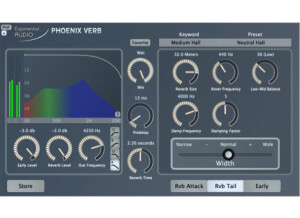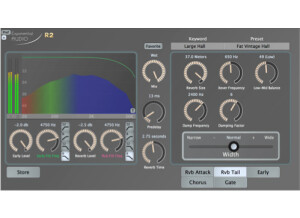Fiche technique
- Fabricant : Exponential Audio
- Modèle : Nimbus
- Catégorie : Réverbérations algorithmiques logicielles
- The familiar core of PhoenixVerb, extended in new directions
-
EQ
NIMBUS has 3 EQ sections, each with 6 different types of filters (2 Lowpass, 2 Hipass, Bandpass and Notch). There's EQ on the reverb tail, another EQ on early reflections and a new EQ on input. It's easy to keep problem sounds (traffic and rumble) out of the reverb, create effects, or work around buildup in overused frequencies.
Tempo
Two important delays--predelay and the new reverb delay--can now be locked to tempo. Do you want the predelay an eighth-note behind the source? It's easy. Select the note value you want and then tap in the beat (or follow tempo set by your DAW). Whether subtle or wild, there's a whole new area to explore.
Early Reflections
NIMBUS now provides a choice of several early reflection patterns to broaden your spacial palette. There's even a special 'Vintage' pattern with very low density. This helps to get the sound of some of your old hardware favorites.
Tail Suppression
Have you ever been in the situation where you've got too much reverb on loud passages and too little when it gets quiet? Do you feel like the singer's getting covered when she belts? Let NIMBUS take care of that for you. Tail Suppression is a novel dynamics process that turns down the reverb (by a little or a lot) when the input level increases. You can use it to provide a subtle cleanup or you can really squash it for novel pulsing sounds.
Warp
Sometimes you've got to go a little crazy. That's what the new Warp page is about. Here's what you'll find there:
- A comprehensive compressor/expander that operates on the input signal. Variable attack, release and knee allow you to control how the input feeds into the reverb and the overdrive. Do you want more reverb on quiet passages? Less? You can even approximate the non-linear converters of 30-year-old hardware devices.
- A flexible overdrive circuit. Whether rightly or wrongly, digital devices have always been accused of sounding cool and clinical. You can change that by adding even-partial distortion or even a bit of transistor crud. Actual plates and chambers have real amplifiers--often overdriven--and this is a powerful way to bring that sound into the plugin world.
- Word-size reduction. Call it 'grain'. Call it 'quantization error'. Call it 'fizz'. Whatever you call it, part of the sound of vintage devices is the distortion from their converters and primitive DSPs. You can have that.
Tooltips
Not everybody reads the User Guide. But everybody can use an explanation about what a dial or button actually does. NIMBUS brings tooltips to Exponential Audio. When you launch NIMBUS for the very first time, tooltips are enabled. Hover the cursor over anything and you'll see a description of what it does. Click the tooltips button at the top of the GUI and tooltips stay hidden until you turn them on again--just in case you forget something.
- Over 1200 presets
- Helpful tool-tips to guide new users.
-
Mono-in/Mono-out, Mono-in/Stereo-out, Stereo-in/Stereo-out, depending on workstation.
Plug-in Formats :
AAX 32/64, VST 64, VST3 64, Audio Units 64. - iLok2 required.











